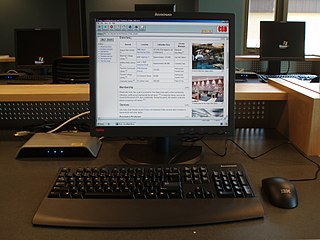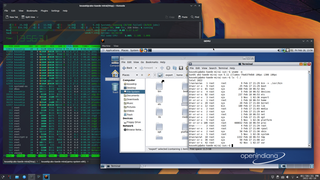
The client–server model is a distributed application structure that partitions tasks or workloads between the providers of a resource or service, called servers, and service requesters, called clients. Often clients and servers communicate over a computer network on separate hardware, but both client and server may be on the same device. A server host runs one or more server programs, which share their resources with clients. A client usually does not share any of its resources, but it requests content or service from a server. Clients, therefore, initiate communication sessions with servers, which await incoming requests. Examples of computer applications that use the client–server model are email, network printing, and the World Wide Web.

A mainframe computer, informally called a mainframe or big iron, is a computer used primarily by large organizations for critical applications like bulk data processing for tasks such as censuses, industry and consumer statistics, enterprise resource planning, and large-scale transaction processing. A mainframe computer is large but not as large as a supercomputer and has more processing power than some other classes of computers, such as minicomputers, servers, workstations, and personal computers. Most large-scale computer-system architectures were established in the 1960s, but they continue to evolve. Mainframe computers are often used as servers.

In computer networking, a thin client, sometimes called slim client or lean client, is a simple (low-performance) computer that has been optimized for establishing a remote connection with a server-based computing environment. They are sometimes known as network computers, or in their simplest form as zero clients. The server does most of the work, which can include launching software programs, performing calculations, and storing data. This contrasts with a rich client or a conventional personal computer; the former is also intended for working in a client–server model but has significant local processing power, while the latter aims to perform its function mostly locally.
Systems Network Architecture (SNA) is IBM's proprietary networking architecture, created in 1974. It is a complete protocol stack for interconnecting computers and their resources. SNA describes formats and protocols but, in itself, is not a piece of software. The implementation of SNA takes the form of various communications packages, most notably Virtual Telecommunications Access Method (VTAM), the mainframe software package for SNA communications.

In computing, a windowing system is a software suite that manages separately different parts of display screens. It is a type of graphical user interface (GUI) which implements the WIMP paradigm for a user interface.

In computer science, inter-process communication (IPC), also spelled interprocess communication, are the mechanisms provided by an operating system for processes to manage shared data. Typically, applications can use IPC, categorized as clients and servers, where the client requests data and the server responds to client requests. Many applications are both clients and servers, as commonly seen in distributed computing.

Client is a computer that gets information from another computer called server in the context of client–server model of computer networks. The server is often on another computer system, in which case the client accesses the service by way of a network.
The Distributed Computing Environment (DCE) is a software system developed in the early 1990s from the work of the Open Software Foundation (OSF), a consortium founded in 1988 that included Apollo Computer, IBM, Digital Equipment Corporation, and others. The DCE supplies a framework and a toolkit for developing client/server applications. The framework includes:
In computing, phoning home is a term often used to refer to the behavior of security systems that report network location, username, or other such data to another computer.

A 3270 Emulator is a terminal emulator that duplicates the functions of an IBM 3270 mainframe computer terminal on a computer, usually a PC or similar microcomputer.
LINC is a fourth-generation programming language, used mostly on Unisys computer systems.
A network host is a computer or other device connected to a computer network. A host may work as a server offering information resources, services, and applications to users or other hosts on the network. Hosts are assigned at least one network address.

Desktop virtualization is a software technology that separates the desktop environment and associated application software from the physical client device that is used to access it.
Secure messaging is a server-based approach to protect sensitive data when sent beyond the corporate borders, and it provides compliance with industry regulations such as HIPAA, GLBA and SOX. Advantages over classical secure e-mail are that confidential and authenticated exchanges can be started immediately by any internet user worldwide since there is no requirement to install any software nor to obtain or to distribute cryptographic keys beforehand. Secure messages provide non-repudiation as the recipients are personally identified and transactions are logged by the secure email platform.
EntireX DCOM is a commercial implementation of Microsoft's Distributed Component Object Model (DCOM) technology by Software AG for the Windows, AIX, HP/UX, Solaris, Linux, AS/400, z/OS, z/VM, and BS2000/OSD platforms.

In computing, virtualization (v12n) is a series of technologies that allows dividing of physical computing resources into a series of virtual machines, operating systems, processes or containers.
TCS BaNCS is a core banking software suite developed by Tata Consultancy Services for use by retail banks.
An Information Technology Assistant is a person who works as an assistant in the IT business.
Linux on IBM Z or Linux on zSystems is the collective term for the Linux operating system compiled to run on IBM mainframes, especially IBM Z / IBM zSystems and IBM LinuxONE servers. Similar terms which imply the same meaning are Linux/390, Linux/390x, etc. The three Linux distributions certified for usage on the IBM Z hardware platform are Red Hat Enterprise Linux, SUSE Linux Enterprise Server, and Ubuntu.

Computers can be classified, or typed, in many ways. Some common classifications of computers are given below.








